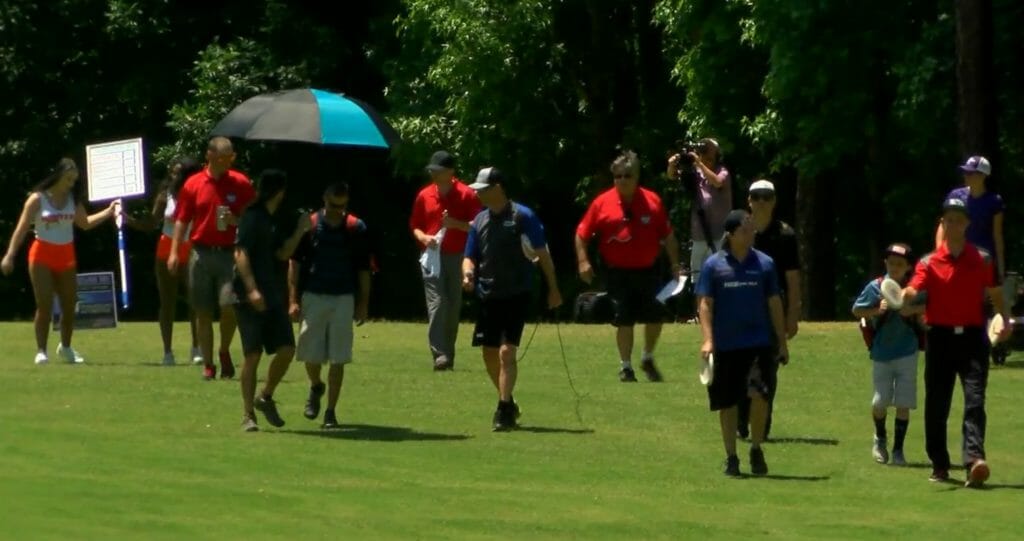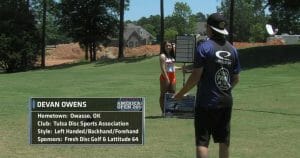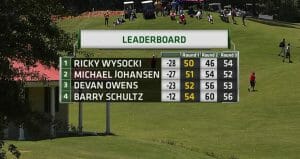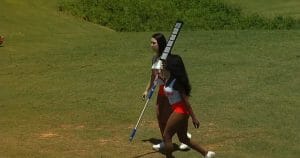High grades for streaming quality, but many other aspects missed the mark.
May 16, 2016 by Steve Hill in Analysis with 4 comments

Leading up to the American Open, the first disc golf event to be broadcast live on ESPN3, American Disc Golf Tour co-founder Steve Boucher promised “a couple things that have never been done on live broadcasts on any sport anywhere.” It was a bold proclamation, and one that set expectations sky high for an event that was already, for better or worse, awaited with anticipation.
With that in mind, we tuned in yesterday and found a production that was high on sizzle, but low on the steak. Solid video quality anchored the stream, but there were definitely some points where the event did not deliver as promised.
Video quality: A
Boucher advertised that this would not be a “YouTube, iPhone, back pack production,” and on that promise, the American Open delivered. The streaming quality through the ESPN3 portal was fantastic, with the signal remaining strong through the event and video displayed in high definition. In this regard, the live coverage echoed some of the post-produced coverage we have seen from the likes of The SpinTV, and that kind of quality being shown in real time was a win.
Audio quality: B-
For the most part, the sound mixing was clear and lead commentator Billy Crump was easy to hear. There were a few times, though, when the event got too cute by trying to kick the commentary to Barry Schultz – who was playing and providing co-commentary – and his microphone was not loud enough, on a delay, or picking up too much background noise. In fact, the hot mic issues dogged the event all day, showing that, for all the talk of a professional event, there were still some first-timers behind the scenes.
Graphics: D

On the surface, a D seems harsh for the graphics, as the ESPN-themed name plates and replay bumps screamed high quality. In that regard, the graphics were tremendous.
But how long did it take to even see a leaderboard in the broadcast? Too long, as the scores were not shown until Hole 4, more than 35 minutes into the broadcast. For a sport where the score is tallied after every hole, that is absolutely unacceptable. To add injury to insult, the scores shown were not up-to-date, as they reflected the totals after the third round of 18 holes and did not account for the final that was being played.
In addition, the budget behind this event should have allowed for a leaderboard to be pinned on the screen for the entirety of the event so that anyone walking in from the other room could see where the event was in the moment. Add to that a misspelling of the word ‘Latitude’ on player cards, and the whole graphics situation was just a huge missed opportunity.
Commentary: B-
While Billy Crump’s Southern drawl doesn’t always sound professional, there isn’t much one can do about an accent, and that aside he handled the job with aplomb. Did he talk a few too many times about “paying the bills” when it came time for a commercial break? Sure. But viewers also learned plenty about the players involved, including that Ricky Wysocki comes from a large family and was home-schooled. He provided a level of familiarity that was relatively accessible.
The addition of Barry Schultz as player-commentator was a nice idea, but poorly executed. It would have been better to have Schultz not playing and simply acting as a “sideline reporter” Crump could throw it to when there was a need for some insight. Otherwise, it came off as a bit gimmicky.
Production/Editing: C-

“Who wants to see guys walking from their drive to their putt?” Boucher asked in our feature on the event. The answer: No one, so we expected to see some pre-produced assets after players completed their drives on the first hole of the finals.
But there we were, watching guys walking from their drive to their putt.
Additionally, it’s going to be tough to get disc golf viewers engaged if they have no concept of where the basket is on a hole or where the disc is flying to, and there were numerous occasions throughout the event in which the camera crew tracked the disc but there was no basket to be found for perspective. Even on Schultz’s first putt, the camera stayed on him long after he released his shot and viewers almost missed his putt clanging off the top of the basket. Cuts from the tee cam to the catch cam were often slow, leaving some lag in capturing the flight, and camera angles – or lack thereof – often left Crump guessing as to where a player was or who would be next to throw.
In what we can only guess was an effort to keep production costs down, two consecutive holes played to the same basket from different tee pads. The cameras were barely moved to cover those shots, though, so it took us, as viewers, a moment to realize that, no, this was not a replay, but a separate hole from a new teepad. In addition, the lack of any course flyovers or hole maps prior to each tee shot – something that has come to be standard on both live and post-produced disc golf programming on YouTube – provided the viewer with little perspective on how players would tackle each hole.
That said, the videos of “Superstars of the Game” that were included as filler material shone a nice light on the pioneers of the sport (although the “Steady” Ed Headrick retrospective came way too late in the broadcast). The event didn’t quite “tell golf’s story,” but it did provide viewers with some much-needed perspective on the game’s greats, especially given the thin pro field at the event.
Course: C-
In retrospect, lack of maps or flyovers didn’t matter. The Cobblestone Park course, while beautiful, did not provide for terribly compelling disc golf. The shots were mostly open and did not call for many creative lines. At least with prior events on golf courses – The Memorial Championships and the Glass Blown Open come to mind – open holes were augmented with out-of-bounds lines, or some shots called for players deploying a roller. The layout at the American Open, though, did not leave us salivating for more. Save the second green being guarded by some trees and the final hole playing over water, it was pretty mundane golf.
Extras: D

The opportunity for players to win a Jeep with an ace on the first hole of the final was likely a fun addition for the amateur disc golfers involved in the event. But with the first hole of the livestream starting on the same hole, and with numerous mentions of players being upset that they didn’t win a car, the shot came off as incredibly contrived. In what was supposed to be a professional event, it gave the whole vibe a sideshow feel.
But that was nothing compared to the waitresses from the local Hooters establishment carrying the scoreboard throughout the broadcast.
On a day when no women were playing, and one day after the PDGA Women’s Global Event – which was highlighted during the broadcast, to the tour organizers’ credit – having a couple scantily-clad women on screen was an extremely tone deaf move by the American Disc Golf Tour. Yes, other sports have done it, but it did not fit the tone of the event. Plus, if you’re going to have people carrying a scoreboard, why not zoom in on it occasionally so viewers can see scores? Instead, it was bright orange hot pants in the background causing more of a distraction than being actually useful.
Overall: C-
The American Open was not a trainwreck by any stretch of the imagination, but it did not provide anything groundbreaking. The only aspect we saw that might qualify as having never been done on a live sporting event was the Barry Schultz as player-commentator angle, which was more MTV Rock & Jock softball game than professional golf tournament. In watching a replay, I was left with the distinct impression that, in its current iteration, disc golf is not made for live coverage. In order to make the pace of play seem less laborious and to cut down on the number of commercials needed during down time, more cards will have to be covered. Until the money is there to do that – and even with the hype of this event, it wasn’t there – live coverage is only for the hardest of hard core disc golf fans.
At the end of an awkward awards ceremony, in which it appeared that players were handed sandwich bags full of cash, a hot mic caught a child asking “How much is that?” A male voice responded with “Whatever it is, it isn’t enough,” and that seemed like a fitting end to the event. Not bad, not great, and certainly only an upgrade in signal strength over existing disc golf productions, the broadcast ended up being more like the Amehrcian Open than a truly watershed event for the sport. Those who were concerned that the folks behind the event would bring disc golf to its eventual demise can rest easy, and those hoping for the next big thing can keep searching.